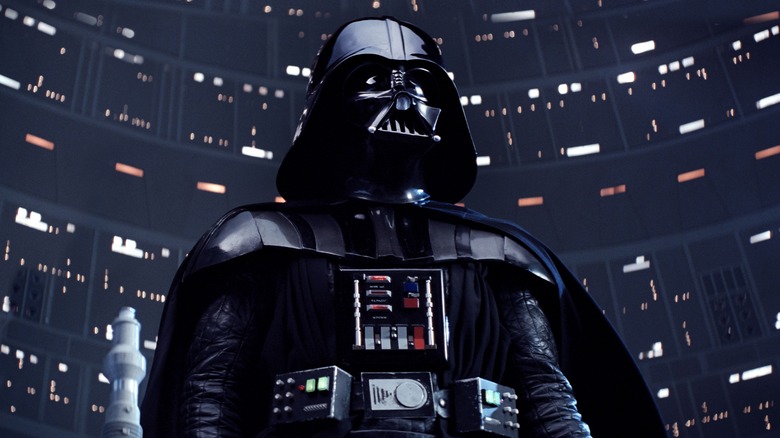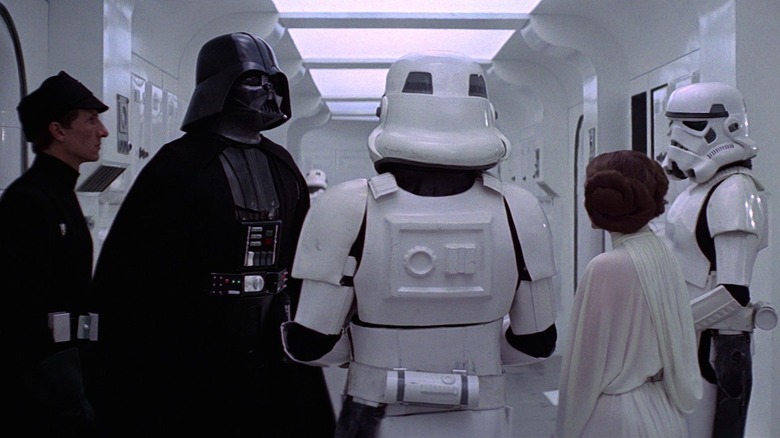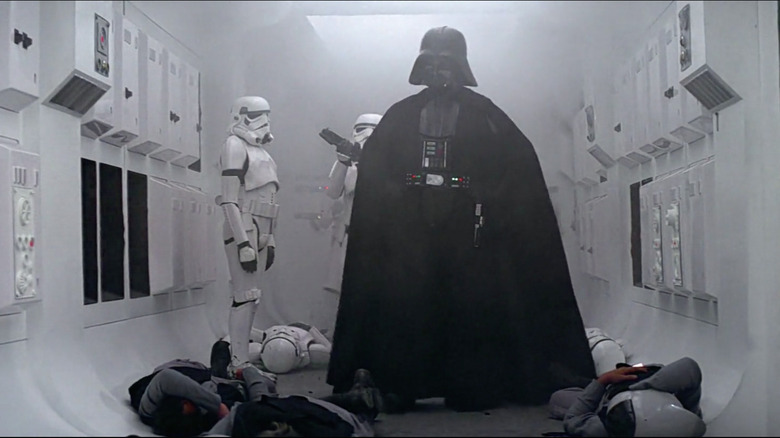Darth Vader's Helmet Design Solved A Practical Problem In The Star Wars Script
The shiny polish, the mechanical breathing, the ominous voice, and the mysterious figure within. Few things in cinema history, if anything, are as iconic as Darth Vader's imposing helmet. The protective armor served as a symbol of pure evil and the dark side of the force, not only in a galaxy far, far away but also in our own. Although only on screen for around 12 minutes in "Star Wars: A New Hope," Lord Vader left an indelible mark on audiences for decades to come. His very presence remains frightening even to veteran "Star Wars" actors to this day.
While George Lucas largely gets the credit for all things "Star Wars," a lesser-known concept artist equally influenced the Darth Vader we know and love (and fear) today. In fact, the iconic helmet worn by the galaxy's most memorable Sith lord exists all because of a small practical issue with the "Star Wars" script.
From drawing the moon to a galaxy far, far away
In the "Star Wars Insider" magazine (issue #76), conceptual artist Ralph McQuarrie reveals how he got involved with Lucas and the "Star Wars" franchise. The closest sci-fi work he'd done was drawings of the moon for CBS News during the Apollo lunar missions. His moon drawings caught Lucas' attention, and the two had a meeting in 1972 to discuss an idea Lucas had for a sci-fi film. Three years later, Lucas contacted McQuarrie to help him conceptualize the characters for the project they discussed, now known as "Star Wars." McQuarrie recalled their first meeting:
"He visited with his friends at my place and talked about a big space-fantasy film he wanted to do. It didn't have a title yet. I showed him a proposal I'd worked on in 1972 for a science-fiction film called 'Galaxy'...I never thought I'd see him again, and then one day he called to see if I'd be interested in doing something for 'Star Wars.'"
McQuarrie is credited with the conceptual art for dozens of the characters and locations now embedded in "Star Wars" lore, and his unused concept art even influenced the "Star Wars" sequel trilogy. Together, Lucas and McQuarrie designed the desert landscape of Tatooine, the hairy Wookie named Chewbacca, C-3PO's golden chassis, the Imperial Stormtroopers, and more. But when it comes to perhaps the most iconic look of any character in "Star Wars," Darth Vader, McQuarrie can take all the credit, and it happened because he discovered a big problem with the script.
Early Darth Vader looked a lot different
Long before Rian Johnson subverted all of our expectations of the Force by having Princess Leia floating through the vacuum of space without any protection, Lucas had a similar vision. Or rather, an oversight. Despite Vader entering the hostile grounds of outer space when passing between spaceships, early designs of Darth Vader had him with silk coverings over his face rather than a full helmet. McQuarrie pointed out why that was a problem beginning with the opening scene of the film:
"George said he wanted a costume that would flutter in on the wind, sort of a dark guy in a black cape with a big helmet, like a Japanese warrior, maybe with black silk over his face or something like that. But the script had Vader crossing between his spaceship and the Rebel Blockade Runner and breaking into that spaceship from outer space, burning his way through a wall so he and his Stormtroopers can come charging into this hallway. I thought, 'Gee, Darth Vader has to function in a vacuum,' so I suggested to George that [Vader] might have some sort of spacesuit to enable him to survive this trip through the vacuum, and George said, 'Well, okay, give him some kind of a breathing apparatus.' So along with the big helmet, I put a mask on him."
And just like that, the quintessential look for the character that sits atop almost every "best film villain" list was born. Despite all of Lucas' inspiration and ingenuity, it was the observation of a largely anonymous artist that completed the look for Darth Vader and filled a major problem with the script. Impressive. Most impressive.


